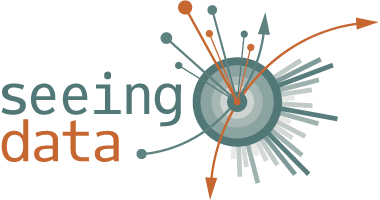‘Do We Have to Visualise Everything?!’ Engaging with the Public
Over the past couple of months, we’ve been drawing on our emergent findings to engage with different groups. In February, Rosey and Andy worked with secondary school-aged students in Leeds as part of the Jampacked events which introduces them to computing and programming. Later, in March we developed that into fuller, two-hour workshops for researchers at the University of Sheffield and University of Oxford. Our key aim was to help improve people’s visualisation literacy: what kinds of visualisations are around, how to read them more confidently, and what to be on the look-out for.
The workshops featured a mix of group work, short presentations by team members, and rating some of the visualisations we had used in the focus groups (if you want to have a go yourself, check out the ‘Rate These Visualisations‘ part of our website). In one of the activities led by Andy, our participants worked in small groups to think of ways they could visualise a large dataset about the Olympics since 1896—medallists, winning times, all sorts of information. What chart types would they use? How would they design interactivity into their concept—if at all?
Now, what we didn’t immediately tell our workshop participant is that Andy already had ‘one I made earlier’, in the form of the work ‘Pursuit of Faster’ seen here. But the point of this activity was to help our participants experience one of the greatest challenges from the perspective of a designer: picking out what angles or interesting bits to visualise in the first place. ‘Do we have to visualise everything?!’ some of them asked, incredulous at the task’s feasibility in the 10-15 minutes we gave them. For me, that kind of comment really illustrates some of the crucial questions throughout this research. What is left unshown, and why? What kinds of choices are made through the process of creating a visualisation—and, on the other side as a ‘reader’, in its interpretation?
This last point, I think, is crucial because it highlights the importance of being critical of what we see—not only during election campaigns but in everyday life too. Being able to make sense of data wherever we encounter it is really important, not only for picking out the vital information, but also for being aware of misleading or confusing images. In fact, as the short experience of ‘designing’ the Olympic visualisation impressed upon me, there may be very practical reasons for why the images we see were designed the way they were: sometimes, we can’t (or don’t want to) visualise everything for everyone.
If you’d like to learn more about visualisations—including how to read some of the most popular types—check out the other part of our website ‘Understanding Data Visualisations’. You can watch video introductions, read materials covering the process of making visualisations, and even test your understanding with quizzes at the end of some modules.
We have more public engagement activities and publications planned, so stay tuned as they come out! All the details and links will be posted on our Twitter feed, @Seeing_Data.
